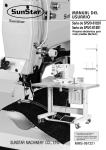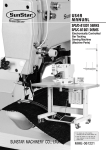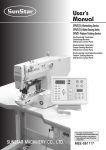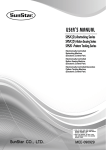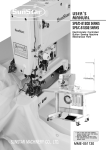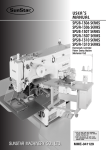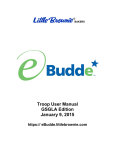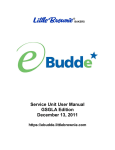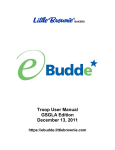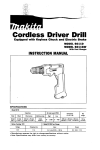Download USER'S MANUAL
Transcript
R USER’S MANUAL SPS/ D-B1254 Series SPS/ D-B1263 Series Direct Drive, Electronically Controlled Decorative Pattern Tacking Machine (Mechanical Part) 1) FOR AT MOST USE WITH EASINESS, PLEASE CERTAINLY READ THIS MANUAL BEFORE STARTING USE. 2) KEEP THIS MANUAL IN SAFE PLACE FOR REFERENCE WHEN THE MACHINE BREAKS DOWN. SUNSTAR MACHINERY CO., LTD. MME-051130 lity a u tQ Besst Pricevice Be st Ser Be 1. Thank you for purchasing our product. Based on the rich expertise and experience accumulated in industrial sewing machine production, SUNSTAR will manufacture industrial sewing machines, which deliver more diverse functions, high performance, powerful operation, enhanced durability, and more sophisticated design to meet a number of user’s needs. 2. Please read this user’s manual thoroughly before using the machine. Make sure to properly use the machine to enjoy its full performance. 3. The specifications of the machine are subject to change, aimed to enhance product performance, without prior notice. 4. This product is designed, manufactured, and sold as an industrial sewing machine. It should not be used for other than industrial purpose. R SUNSTAR MACHINERY CO., LTD. Organization of the Pattern Tacking S/M MODEL SPS / D - B12 HA ⑧ Hook Type BL : Large Shuttle Hook ① SunStar Pattern System ⑦ Option ② Series TH : Upper Thread Holding Device D : Direct Drive Type ⑥ Feed Frame Driven Type ③ Pattern Tacking Model Name 54 : 50×40mm 63 : 60×30mm ④ Material Type H : Heavy Weight Material M : Medium Weight Material 20 : Mono Lithic Feed Frame 22 Separately Driven Feed Frame ⑤ Pneumatic Type (Standard) Contents 1. Machine Safety Regulations 6 6 6 7 7 8 8 2. Machine Specifications 9 3. Machine Structure 1) Names of Each Part of the Machine 4. Machine Installation 10 10 11 1) Machine Installation Conditions 2) Electric Installation Conditions 3) How to Install the Table 4) The Assembly of Peripheral Parts 5) Installation Method of Air Pressure Specifications 11 11 11 14 15 5. Preparations Before Operating the Machine 18 1) How to Supply Oil 2) How to Install the Needle Bar 3) How to Thread the Upper Thread 4) Threading the Lower Thread 5) How to Take the Bobbin Case On and Off 6) How to Adjust the Tension of the Upper Thread and the Lower Thread 7) How to Wind the Lower Thread 8) How to Operate a Pedal ( A-20 Type) 9) How to Operate a Pedal ( A-22 Type) 10) Disposing the Waste Oil 11) Compressed Air Input and Air Pressure Adjusting Method 12) Adjusting Method of Upper Thread Holding Device (Option) 4 6 1) Machine Transportation 2) Machine Installation 3) Machine Repair 4) Machine Operation 5) Devices for Safety 6) Caution Mark Position 7) Contents of Marks 18 19 20 20 20 21 21 22 22 22 23 23 6. How to Repair the Machine 1) Adjusting the Height of the Needle Bar 2) Adjusting the Needle and the Shuttle 3) Adjusting the Lower Shaft Gear and the Rocking Shaft Gear 4) Adjusting the Position of Shuttle Upper Spring 5) Adjusting the Height of the Feed Plate 6) Adjusting the Height of the Presser Foot Devices 7) Adjusting the Presser Foot Devices 8) Adjusting the Parts for Thread Release 9) Adjusting the Wiper Parts 10) Adjusting the Parts for Trimming 11) Adjusting the Devices for Main Thread Adjustment 12) Adjusting the Winder Devices 13) Adjusting the Hand Pulley Device 14) Mounting the Direct Motor and Adjusting Method 15) Setting Up the X-Y Origin 7. Cause of Breakdown and Troubleshooting 1) Machine Part 24 24 24 25 25 26 26 26 28 30 31 33 33 34 34 35 36 36 8. Pattern List 37 9. Drawing of Table 39 10. Gauge List 40 11. Pneumatic Diagram 43 1) Drawing of the Pneumatic Hose of SPS/D-B1254 A-20, SPS/D-B1263 A-20 Machine (for Monolithic Feed Frame) 2) Drawing of the Pneumatic Hose of SPS/D-B1254 A-22, SPS/D-B1263 A-22 Machine (for Separately Driven Feed Frame) 43 44 5 1 MACHINE SAFETY REGULATIONS Safety instruction on this manual are defined as Danger, Warning and Notice. If you do not keep the instructoins, physical injury on the human body and machine damage might be occurred. Danger : This indication should be observed definitely. If not, danger could be happen during the installation, conveyance and maintenance of machines. Warning : When you keep this indication, injury from the machine can be prevented. Notice : When you keep this indication, error on the machine can be prevented. 1-1) Machine Transportation Danger 1-2) Machine Installation Notice 1-3) Machine Repair Danger 6 Those in charge of transporting the machine should know the safety regulations very well. The following indications should be followed when the machine is being transported. ⓐ More than 2 people must transport the machine. ⓑ To prevent accidents from occurring during transportion, wipe off the oil on the machine well. The machine may not work well or breakdown if installed in certain places, install the machine where the following qualifications agree. ⓐ Remove the package and wrappings starting from the top. Take special notice on the mails on the wooden boxes. ⓑ Dust and moisture stains and rusts the machine. Install an airconditioner and clean the machine regularly. ⓒ Keep the machine out of the sun. ⓓ Leave sufficient space of more than 50㎝ behind, and on the rigth and left side of the machine for repairing. ⓔ EXPLOSION HAZARDS Do not operate in explosive atmospheres. To avoid explosion, do not operate this machine in an explosive atomsphere including a place where large quantities of aerosol spray product are being used or where oxygen is being administered unless it has been specifically certified for such operation. ⓕ The machine were not provided with alocal lighting due to the feature of machine. Therefore the illumination of the working area must be fulfilled by end user. [Refer]Details for machine installment are described in 4. Machine Installment. When the machine needs to be repaired, only the assigned troubleshooting engineer educated at the company should take charge. ⓐ Before cleaning or repairing the machine, close down the motive power and wait 4 minutes till the machine is completely out of power. ⓑ Not any of the machine specifications or parts should be changed without consulting the company. Such changes may make the operation dangerous. ⓒ Spare parts producted by the company should only be used for replacements. ⓓ Put all the safety covers back on after the machine has been repaired. 1-4) Machine Operation Warning SPS/D-B1254(B1263) Series is made to sew patterns on fabrics and other similar material for manufacturing. Follow the following indications when operating the machine. ⓐ Read through this manual carefully and completely before operating the machine. ⓑ Wear the proper clothes for work. ⓒ Keep hands or other parts of the body away from the machine operation parts(needle, shuttle, thread take-up lever, and pulley etc.) when the machine is being operated. ⓓ Keep the covers and safety plates on the machine during operation. ⓔ Be sure to connect the earthing conductor. ⓕ Close down the electric motive power and check if the switch is turned“off ”before opening electric boxes such as the control box. ⓖ Stop the machine before threading the needle or checking after work. ⓗ Do not step on the pedal when turning the power on. ⓘ Do not operate the machine with any cooling fan blocked. The air-filter on control box must be cleaned once a week. ⓙ If possible, install the machine away from source of strong electrical noise such as high frequency welding machines Warning 1-5) Devices for safety Warning Belt will crush or amputate finger or hand, keep cover in place before operating, turn off power before inspecting or adjusting. Safety label : It describes cautions during operating the machine. Thread take-up cover : It prevents from any contact between body and take-up lever. Motor cover : It prevents from insertion of hands.feet or clothes by motor. Label for specification of power : It describes caution for safety to protect against electric shock during rotation the motors. ⓔ Finger guard : It prevent from contacts between a finger and needle. ⓕ Safety plate : It protect eyes against needle breaks. ⓐ ⓑ ⓒ ⓓ ⓐⓑ ⓔ ⓒ ⓕ ⓓ 7 1-6) Caution Mark Position Caution mark is attached on the machine for safety. When you operate the machine, obesrve the directions on the mark. Position of Warning Mark [View from the right-front] CAUTION 주 의 Do not operate without finger guard and safety devices. Before threading, changing bobbin and needle, cleaning etc. switch off main switch. 손가락 보호대와 안전장치 없이 작동하지 마십시오. 실, 보빈, 바늘교환시나 청소전에는 반드시 주 전원의 스위치를 꺼 주십시오. WARNING 경 고 Hazardous voltage will cause injury. Be sure to wait at least 360 seconds before opening this cover after turn off main switch and unplug a power cord. 고압 전류에 의해 감전될 수 있으므로 커버를 열 때는 전원을 내리고 전원 플러그를 뽑고 나 서 360초간 기다린 후 여십시오. 1-7) Contents of Marks Caution 1) CAUTION 주 의 Do not operate without finger guard and safety devices. Before threading, changing bobbin and needle, cleaning etc. switch off main switch. Warning 손가락 보호대와 안전장치 없이 작동하지 마 십시오. 실, 보빈, 바늘교환시나 청소전에는 반드시 주전원의 스위치를 꺼 주십시오. 2) WARNING 경 고 Hazardous voltage will cause injury. Be sure to wait at least 360 seconds before opening this cover after turn off main switch and unplug a power cord. 고압 전류에 의해 감전될 수 있으므로 커버 를 열 때는 전원을 내리고 전원 플러그를 뽑 고 나서 360초간 기다린 후 여십시오. 8 2 MACHINE SPECIFICATIONS SPS/D-B1254 SPS/D-B1263 MODEL HA Application Sewing Area(X, Y) HA-BL For Heavy Weight Materials MA MA-BL For Medium Weight Materials HA HA-BL For Heavy Weight Materials 50mm×40mm MA MA-BL For Medium Weight Materials 60mm×30mm Sewing Speed Max. 2,500spm (Stitch Length is 3mm or Less) Stitch Length 0.1∼10mm Feeding System Feeding by Pulse Motor Stroke 41.2mm Hook Standard Large shuttle Standard Large shuttle Standard Large shuttle Standard Large shuttle Shuttle Hook hook Shuttle Hook hook Shuttle Hook hook Shuttle Hook hook Needle DP×17 #19 (#19∼#23) DP×17 #19 (#19∼#23) DP×5 #16 Lifting Amount of Feeding Frame Max. 20mm Lifting Amount of Presser Foot Max. 20mm Thread Trimmer Standard Emergency Stop Switch Standard Wiper Standard (Electronically Solenoid Type) No. of Stitches Max. 10,000 Stitches Standard No. of Patterns 56 Patterns (Pattern : 24, Bartack : 32) Number of Patterns Max. 99 Pattems (Standard 56 Patterns) Memory EP-ROM Enlarging/Reducing 20%∼ 200% (1% Step) Motor Direct Drive AC Sero Motor Power Consumption 600VA Recommended Temperature 5°C∼40°C Recommended Humidity 20%∼ 80% Power 1-Phase: 100V∼240V, 3-Phases 200V∼440V, 50/60㎐ Ariborne Noise Humidity 0.49MPa (5kgf/cm²) DP×5 #16 9 3 MACHINE STRUCTURE 1) Names of Each Part of the Machine Motor Cover Arm Thread Stand Emergency Stop Switch Safety Plate Ass’y Operation Box Power Switch Pedal Switch 10 4 MACHINE INSTALLATION 1) Machine Installation Conditions A. Do not use the machine where the voltage is over regular voltage ±10% to prevent accidents B. For safe operation of the machine, use the machine under the following conditions. Surrounding Temperatuer During Operation : 5。~40℃ (41。F~104。F) Surrounding Temperature During Maintenance : -10。~60℃(14。F~140。F) C. Humidity : Between 20~80%(Relative humidity) 2) Electric Installation Conditions A. Power Voltage · The power voltage must be between regular voltage ±10% · The frequency of the power should be regular frequency(50/60㎐) ±1% B. Electromagnetic Wave Noise Use separate power with strong magnetics of high frequency products, and do not leave the machine near them. C. Ues low voltage when supplements or accessories are being adhered. D. Be careful not to have water of coffee be spilled into the Controller and Motor. E. Do not drop the Controller or Motor. 3) How to Install the Table A. Please fix the oil tub support ①, the oil support ②, the control box ③ and the power switch ④ on the table. ② ① ④ ③ [ Fig. 1 ] B. Attach the bed cushion rubber ① and safety switch supporting rubber ② to the table. ① ② [ Fig. 2 ] 11 C. Add the hinge metal and hinge rubber to the bed. Then insert the fixing bolt into the hinge metal hole of point ① and fix the table as shown in the picture. Bolt Hinge Rubber The machine should be carried by more 2 people for safety Danger ① Hinge [ Fig. 3 ] D. Stand the machine as shown in the picture, and then fix the machine on the table after inserting the fixing bolts into the hinge metal holes of point ①. ① Danger Since the machine is not perfectly installed on the table, extreme care is needed when you make the machine stand up not to have any accident occurred. Bolt ① [ Fig. 4 ] E. Assemble the safety switch bracket ① on the bed as in the figure. Move the safety switch bracket up and down to make sure that the safety switch supporting rubber ② is tightly pressed by the safety switch ③, and then fasten the screw ④. ① ② ④ ③ [ Fig. 5 ] 12 F. After the cable connections beween the machine and the control box is finished, fix the cable wiring under the table as shown in the picture. (Adjust the length of the wire considering the situation of standing the machine.) Table [ Fig. 6 ] 13 4) The Assembly of Peripheral Parts A. Attach the motor cover on the back side of the machine (4 positions) by using the 4 joint screws. Fixing Screw Motor Cover [ Fig. 7 ] B. Attach the safety plate to the left side of machine by using fixing bolt. Face Plate Safety Plate Ass’y [ Fig. 8 ] For safety, motor cover and safety plate should be attached to the machine. Caution C. Install the thread stand on the table. [ Fig. 9 ] 14 5) Installation Method of Air Pressure Specifications A. Assembly method of filter regulator attach to right side of the table leg by using a bolt as shown in the figure. [ Fig. 10 ] B. Assembly method of solenoid valve Fix it tightly at the proper location of the table bottom by using the fixing screw. [ Fig. 11 ] 15 C. How to connect the pneumatic hoses of monolithic feed frame machine (for SPS/D-B1254 A-20 / B1263 A-20 machine) ② ① 1. Connect filter regulator and solenoid valve by using the hose ①. ① 2. Insert the hoses labelled“S3F”and“S4F”to the A and B part as shown in figure. (Confirm the noses are inserted filly.) 3. Using quick couplings ②, connect “S3L”&“S3R” to S3F and“S4L”&“S4R”to S4F” 4. Finally, connect the solenoid and the connector of pressure swith. [ Fig. 12 ] 16 D. How to connect the pneumatic hoses of the separately driven feed frame machine (for SPS/D-B1254 A-22 / B1263 A-22 machine) Air Hose Cap Net Hose Nipple ① 1. Connect filter regulator and solenoid valve by using the hose ①. 2. Assemble the hose with the label of“S3L, S4L, S3R, S4R”to the attaching part of solenoid as shown in the figure 3. Finally, connect the solenoid and the connector of pressure switch. (Please match the label of solenoid and connector and connect them.) [ Fig. 13 ] 17 5 PREPARATIONS BEFORE OPERATING THE MACHINE 1) How to Supply Oil A. Check the amount of oil left in the oil tank which is installed on the arm and supply oil stufficiently. Caution Be sure to supply oil when operating the machine for the first time and when the machine has not been used for a long time. [ Fig. 15 ] B. Check the remained amount of oil from the right window(Oil gauge window) of oil tank installed on the bed as seen in the figure, then supply oil enough through the lubrication hole on the bed cover. [ Fig. 16 ] C. Supply oil into the hole in the upper part of the arm. [ Fig. 17 ] 18 D. Open the hook cover and supply oil till the shuttle race ring is surrounded by oil. Put the hook cover back on after finishing. Caution For safety, keep the hook cover covere during operating. Shuttle Race Ring Hook Cover [ Fig. 18 ] E. Supply sillicon oil into the sillicon oil tank which is installed on the right side of the arm. Sillicon Tank [ Fig. 19] 2) How to Install the Needle Bar Unfasten the needle fixing screw on the needle bar. Then, with the needle groove facing forward, push the needle until the upper end touches the needle hole of the needle bar. Fix the needle in with the needle fixing screw. Screw Needle [ Fig. 20 ] 19 3) How to Thread the Upper Thread After placing the thread take-up lever on the top position, hang the upper thread as shown in the Figure. Concerning the thread guide of the needle bar, hang thread to use for heavy weight material as shown in Fig.① and hang thread to use for general and thin knit material as shown in Fig. ②. HA (Heavy Weight Material) MA (Medium Material) Fig.② Fig.① 40mm [ Fig. 21 ] 4) Threading the Lower Thread A. Insert bobbin ① into bobbin case ② as shown in the picture. 25mm Insert the bobbin to turn clockwise when seen from behind the bobbin case ③ Caution ② ① B. After setting the lower thread through the crack of the bobbin case, insert the thread through thread hole ③. C. Adjust the lower thread to hang 25mm out of thread hole ③. [ Fig. 22 ] 5) How to Take the Bobbin Case On and Off Opening the hook cover, hold the knob ① of bobbin case and push into the shuttle until sounding. Caution lf you start operating the machine when bobbin case is not perfectly installed, thread can be tangled of the bobbin case would be protruded. Bobbin Case ① [ Fig. 23 ] 20 6) How to Adjust the Tension of the Upper Thread and the Lower Thread A. Adjusting the tension of the upper Thread When the tension adjusting nuts ③ and ④, of thread tension adjusting unit ① and sub-tension adjusting unit ②, are turned clockwise the upper thread is tightened. And loosens when turned the other way around. ② ④ ① ③ [ Fig. 24 ] B. Adjusting the tension of the lower Thread the lower thread becomes tight when tension adjusting screw ① is turned clockwise, as shown in the picture. When the screw is turned the other way the lower thread is loosened. Strong Weak ① [ Fig. 25 ] 7) How to Wind the Lower Thread A. B. C. D. Press SELECT and select in the operation box. Insert the thread winder basis ① attached on the upper cap of the bobbin into the thread winder drive shaft ②. Adhere the thread winder lever ③ closely to the bobbin, and operate the machine by pressing the pedal. After separating the thread winder lever from the bobbin, cut off thread of the bobbin using the thread winder mes ④. ② ④ Bobbin ③ ① [ Fig. 26 ] 21 8) How to Operate a Pedal ( A-20 Type) A. After providing with the pedal switch of 2 pressing plates, install it a proper position to work conveniently. B. When you are pressing the right pedal the feed plate is lowering down, and when you press it again, the feed plate starts rising. C. In the status that the feed plate is lowered you press the left pedal, lt starts sewing, and when the sewing is finished, the feed plate starts rising. Work the Left Pedal Work the Right Pedal [ Fig. 27 ] 9) How to Operate a Pedal ( A-22 Type) A. It provides with the pedal switch of 2 pressing plates. Install it a proper position to work conveniently. B. When you are pressing the right pedal, the right feed plate is lowering down, and when you press it again, it starts rising. C. When you press a step on the left pedal, the left feed plate starts lowering, and when you take off your foot, it starts rising again. D. In the status that the right feed plate is lowered you press a step on the left pedal, the left feed plate starts lowering, and when you press a second step, it starts sewing. When the sewing is finished, the left and right feed plates start rising automatically. E. Please refer to Page 18 in the electrical and electronic manual concerning how to change the parameters of the separate pedal. Work the Left Pedal Work the Right Pedal [ Fig. 28 ] 10) Disposing the Waste Oil When the oil receiving oiler at the bottom of the table is full, take it off to empty. Caution Spread out some fabrics of papers on the floor when you attach or remove the oil receiving container. Oiler [ Fig. 29 ] 22 11) Compressed Air Input Air Pressure Adjusting Method Please Operate under power-off status for prevention of safety assiden. Note A. Please connect quick joint socket ① that pressed air was connected to the quick joint plug ② attached to the table. ① ③ B. Open the finger valve ③ and input the pressed air. [ Reference ] If you close the finger valve after you use it, automatically dischange the remained air and the remained pressure is indicated as 0 MPa (0 kgf/cm²) ② [ Fig. 30 ] C. After pulling the adjusting handle located on th upper part of filter regulator as shown in the right figure, if you turn it to clockwise direction, the pressure rise and if you turn it to counter clockwise direction, the pressure drops. Therefore, after adjusting to the proper pressure 0.49∼0.54MPa (5∼5.5kgf/cm²) indicated on the pressure gauge, press the adjusting handle to the original location and fix it. Note If the air pressure drops while using is (less than 4kgf/cm²), it shall be indicated as “error”and operation of the machine shall stop.[Er07] [ Fig. 31 ] 12) Adjusting Method of Upper Thread Holding Device (Option) A. Please confirm if upper thread holder pin cylinder knuckle ① and cap ② are located in the center of upper thread passage. B. If they are not located in the center, unfasten two pieces of joint screw ④ of upper thread holder pin cylinder bracket ③ and adjust to be located in the center. Then unfasten two joint screw ④ and adjust to be located in the center and fasten joint screw ④ tightly. C. Standard distance between end of knuckle cap ② and ARM ⑤ should be 4mm. D. In order to adjust this, unfasten two pin cylinder nut ⑥ and adjust distance of front and back. Then if adjustment is finished, fasten two nut ⑥ tightly. ②① ③ ④ ③ ⑥ ⑤ 4mm ⑥ [ Fig. 32 ] 23 6 HOW TO REPAIR THE MACHINE The machine is set to be the best condition at the factory. Do not make any discrete adjustments on the machine and replace genuine parts approved by the company only. Caution 1) Adjusting the Height of the Needle Bar When the needle bar os at its lowest position, unfasten the needle bar holder screw ①. Adjust the desired height by making the specified upper carving line fit in with the needle bar bushing. Then, tigh tenthe needle bar holder screw back in firmly. ① DP×5 DP×17 [ Fig. 33 ] 2) Adjusting the Needle and the Shuttle Needle Bar Lower Bushing A. Have the lower carving line for the needle that is applied when the needle bar goes up fit in with the lower side of the needle bar bushing as shown in the picture. DP×5 DP×17 [ Fig. 34 ] B. After unfastening the shuttle drive screw ①, open the inner hook pressure bar ② left to right and remove the shuttle race ring ③ from the (large) shuttle ④. C. Make the shuttle hook point accord with the center of the needle. And make the needle and the front face of the shuttle drive connect each other to prevent the needle from curving. Then, tighten the drive screw ① firmly. D. After unfastening the (large) shuttle scerw ⑤, turn the large hook adjustment shaft ⑥ to the left to right and adjust the (large) shuttle ④ so that the needle and the shuttle hook point is 0.05∼0.1mm apart from each other. E. After adjusting the (large) shuttle ④ in place, adjust the rotary direction of the (large) shuttle ④ so the needle and the (large) shuttle ④ is 7.5mm apart from each other. Then, tighten the (large) shuttle screw ①. For safety, make sure all the screws are tightened firmly after adjusting the (large) shuttle. Caution 0mm 7.5mm ② 0.05∼0.1mm ② ③ ⑤⑥ ④ ① [ Fig. 35 ] 24 3) Adjusting the Lower Shaft Gear and the Rocking Shaft Gear A. Unfasten screws ① and ②, ③ B. While having the upper shaft turning, move the rocking shaft gear in the direction of the arrow to the position where it will move easily without load. The machine may not operate when the rocking shaft gear in not in the right position. Caution C. Have the oscillator shaft collar (right) stick to the bed surface , and then tighten the collar screw. D. Turn the oscillator shaft collar (right), still sticking to the bed surface , in the direction of the arrow and make adjustments so the end of the shuttle drive will rotate smoothly with the backlash of under 0.1mm. If there is too much backlash the machine may make more noise than usual during operation. And if there is not enough backlash, the machine may not operate. Caution E. Tighten screw ① and ③ back on firmly. Oscillator Shaft Collar(R) ③ Backlash 0.1mm and Below ① ② [ Fig. 36 ] 4) Adjusting the Position of Shuttle Upper Spring After removing the lower feed plate and the needle plate from the machine, unfasten the screw of the shuttle upper spring. Then, adjust the shuttle upper spring so that the backside of the needle and comes to point in the vertical direction, and the center of the needle will come to the middle of interval horizontally. After the adjustment is done, tighten the screw back on firmly. Caution The thread may be disconnected or the thread strand may be unfastened if there are scratched or if the surface is rough around the shuttle upper spring. Always check the surface of the spring before operating the machine. ① ① ① [ Fig. 37 ] 25 5) Adjusting the Height of the Feed Plate. Unfasten the cylinder knuckle joint nut ③ attached on the left and right cylinders ② on the feed bracket ①. And when you raise the cylinder knuckle ⑤ to direction A by rotating the cylinder shaft ④, the height(T) of the feed plate ⑥ is set up highly, and when you lower the cylinder knuckle ⑤ to direction B by rotating the cylinder shaft ④, the height(T) of the feed plate ⑥ is set up lowly. Be sure to fix the cylinder knuckle joint nut tightly after adjusting the height of the feed plate ⑥. ⑤ ① T ③ A ④ S B ② ⑥ [ Fig. 38 ] 6) Adjusting the Height of the Presser Foot Devices A Unfasten the presser foot joint screw ① at the lowest position of the needle bar. B. Adjust the height of the presser foot to correct the distance between the presser foot bottom surface and the sewing material to be 0.5mm (the thickness of using thread) and then fasten the joint screw. → → Caution ① Make sure to check the position of the wiper after adjusting the height of the presser foot. ·A flipping away shall be caused by a wide interval. ·A malfunction of the thread adjusting shall be caused by a narrow interval 0.5mm [ Fig. 39 ] 7) Adjusting the Presser Foot Devices A. Have the end of the presser foot drive cam accord with the carving point center of the upper shaft, and the line of the cam accord with the carving point. Tighten screw ①. Caution lf the presser foot drive cam is not in the rigth position, the presser foot may move vertically in time and run into needle bar. ① Carving Point Upper Shaft Presser Foot Drving Cam [ Fig. 40 ] 26 B. Height Adjustment of Presser Bar Adjust the presser bar that end of presser bar should come out about 17mm from presser bar handle and check if the needle passes through center of presser bar.If checking ends, fasten joint screw ①. Caution Fasten joint screw ① of presser bar with the pressure about 40∼45kgf/cm². If connection pressure is excessive, it becomes cause of deformation of presser bar and cause trouble to machine operation. Presser Bar ① Presser Bar Holder Presser Foot [ Fig. 41 ] C. Adjustment of Presser Foot Adjusting Arm a) Unscrew location link stopper screw to make space between location link stopper ④ and fixing stud screw of presser foot motion link ③. b) After unscrewing fork link joint screw ① and placing stud screw of presser foot link to the right side of presser foot adjusting arm, fasten stud screw ② of presser foot link tightly. c) Place the needle bar to the lowest point by turning the hand pulley. d) Raise the presser bar so that the distance between presser bar handle and presser bar bush is to be 4mm and fasten the joint screw ① of fork link tightly. Caution If there is space between presser bar handle and presser bar bush, interference and noise is occurring during machine operation, screws are not fastened tightly after adjustment; it can cause breakage during operation. e) Adjust so that location link stopper ④ and fixing stud screw of presser foot motion link ③ get close by turning stopper screw of location link. Caution If fixing stud screw ③ of presser foot motion link and end of the location link stopper ④ did not get perfectly close, trembling phenomenon occurs during operation and noise can increase. f) After fastening fork link joint screw ① tightly, check if there is play to vertical direction in presser foot adjusting arm. Checking fastening status of screws, adjust presser foot stroke. Presser Foot Adjusting Arm ② ① ④ ③ 9mm Presser Bar Bush Presser Bar Holder [ Fig. 42 ] 27 D. Adjustment of Presser Foot Stoke(Adjustment of Presser Foot UP/DOWN Motion) After unfastening stud screw ① of presser foot adjusting arm, placing it to A direction, presser foot stroke increases. Placing to direction B, stroke decreases. (It is set to 4mm at the moment of factory shipping). B A ① [ Fig. 43 ] 8) Adjusting the Parts for Thread Release A. How to Set the Thread Release Notch Place the notch so that the right side of the slot of the thread release notch ① touches circumference of the notch screw ②, and then fix with a screw. Caution ② ① The remaining amount of thread may not be enough or not be regular and the thread may be unfasten from the needle if the notch is not set in the right position. Thread Trimming Cam [ Fig. 44 ] B. How to Set the Thread Release Stopper ⓐ Remove the thread release return spring. ⓑ After unfastening the thread release stopper screw, adjust the trimming drive link and the thread release lever pin 0.3mm apart from each other. Then, attach the arm to the thread delay stopper completely. When the thread release stopper is pushed to the right, the space between the trimming drive link and the thread release lever pin is reduced. And it is enlarged when the stopper is pushed to the left. ⓒ Hang on the thread releasd return spring. Use a tool when removing or attaching the thread delay spring to prevent accidents. Caution Thread Release Lever Pin Thread Triming Driving Link Return Spring 0.3mm Widen Narrow Screw Thread Rlelease Stopper [ Fig. 45 ] 28 C. How to adjust the opering capacity of the thread guide disk ⓐ Unfasten the thread release adjusting plate screw. ⓑ Open the thread guide disk by operating the trimming devices. ⓒ Adjust the opening capacity to 0.6∼0.8mm for normal material and 0.8∼1mm for heavy material. To increase the opening capacity, widen the angle between the thread release plate and narrow the angle to reduce the opening capacity. ⓓ Tighten the screw after the adjustment. If the disk is not opened appropriately, the amount of remaining thread may be not enough or not regular, and the disk may not be closed completely. Caution Widen Floating Amount Narrow Upper Shaft Screw Thread Tension Adjusting Plate To Tension Release Link To Thread Tension Adjusting Ass’y [ Fig. 46 ] 29 9) Adjusting the Wiper Parts A. B. C. D. Unfasten the crank fixing screw ① when a needle is stopped upward. Adjust the wiper crank ② for wiper and needle to be apart from about 40mm Fasten the wiper crank fixing screw ① Unfasten the wiper fixing screw ③ and adjust it for wiper tail and needle tip to be apart from about 1mm, then fasten the wiper fixing screw ③. If a position of wiper is not proper, the wiper can be interfered with needle or inverting clamp devices during operating, therefore, precise operation can not be a chieved. Caution ③ ① ② ② 1mm 40mm [ Fig. 47 ] E. For using the wiper, press the wiper operation switch ① and for not using it, press the wiper operation switch ①. Wiper On/Off Switch ① Wiper Off Wiper On [ Fig. 48 ] 30 10) Adjusting the Parts for Trimming A. Setting the position of the trimming Cam Set the upper shaft collar and the trimming cam 1.7mm apart from each other and place the trimming cam where the trimming cam carving line accords with the upper shaft carving point. Then, tighten screw ①. If the trimming cam is not placed in the right position, the trimming operation may not be made correctly or the machine may be lock. Caution 1.7mm Carving Line Thread Trimmer Cam Upper Shaft Carving Point Upper Shaft Upper Shaft Collar ① [ Fig. 49 ] B. How to adjust the link stopper ⓐ With the needle bar in its lowest position, check of there is enough clearance between the trimming cam roller and both ends of the trimming cam when the trimming drive link is pushed in the direction of the arrow( ) within the trimming cam moving part. Caution If there is not enough clearance between the trimming cam roller and both ends of the trimming cam, trimming may not be operated correctly or the machine may be lock when beginning to sew or trimming ⓑ Make the end of the link stopper screw touch part of the trimming link stick when the trimming cam roller is inserted into the trimming cam moving part. Then, tighten the nut. Thread Trimmer Cam Roller Thraed Trimming Driving Link Clearance Clearance ⇒ Caution If the position is not set appropriately, the return to the previous point after trimming may be delayed and the first stitch may not be tight enough. Thread Trimmer Cam Link Stopper Screw Link Stopper Screw Thread Trimmer Connecting Bar Thead Trimmer Connecting Bar Nut [ Fig. 50 ] 31 C. Setting the trimming shaft in place ⓐ Unfasten the trimming drive link screw and the trimming shaft collar screw. ⓑ Make the trimming shaft tip accord with part of the arm. ⓒ Tighten the screws. Caution Thread Timmer Shaft Thread Trimmer Cam If the position is not adjusted appropriately, trimming may not be operated correctly or the machine may be lock. Screw Thread Trimming Collar for Thread Driving Link Trimmer Shaft [ Fig. 51 ] D. Settion up the link stopper position ⓐ Unfasten the joint screw of the thread trimmer drive link stopper in a status the thread trimmer is not operated. And then adjust to correct the notch intervals between the thread driving link and the thread driving link stopper to be 0.3mm each. ⓑ And fasten the joint screw . Caution Screw 0.3mm Thread Trimmer Driving Link An improper setting up of the position could cause a malfunction of the thread trimmer of a machine sticking. 0.3mm Thread Trimmer Driving Link Stopper [ Fig. 52 ] E Setting the thread trimming solenoid in place ⓐ After unfastening the thread trimming solenoid bracket screw, have the trimming shaft and the thread trimming solenoid rotary link 0.5mm apart from each other and tighten the screw back on. ⓑ Unfasten the thread trimming solenoid rotary link screw and drive the thread trimming solenoid rotary link manually to move the trimming shaft collar 6.8mm in the direction of the arrow.Then, tighten the screw back on. ⓒ Check if the trimming shaft collar retums to its place when the thread trimming solenoid rotary link returns. Caution If the position is not set right, the trimming return or the thread delay may be delayed to bring poor sewing quality. Screw Thread Trimmer Solenoid Bracket Solenoid Screw 0.5mm Thread Trimming Rotation Link 6.8mm Thread Trimming Thread Trimmer Shaft Rotation Link [ Fig. 53 ] 32 F. Adjusting the Moving Mes and the Fixed Mes ⓐ When the meedle bar stops at the upper position, use the trimming lever adjustment screw to adjust space A between the thread separation point of the moving mes and the throat plate hole as indicated in the table. ⓑ Use the fixed mes screw to adjust space B between the fixed plate and the throat plate cover as indicated in the table. ⓒ after the adjustment, check the position of the mes by manual trimming operation. Caution Trimming may not be operated or there may not be enough remaining thread if the mes is not set appropriately. Needle Plate Cover B A B 4.5mm 0.5mm Moving Mes Fixed Mes A [ Fig. 54 ] 11) Adjusting the Devices for MainThread Adjustment A. When the tension control nut ① of the thread control device is turned clockwise, the upper thread is tightened and becomes loose as the nut is turned counter clockwise. Adjust the tension according to the sewing conditions such as material, thread, number of stitches etc. Weak B. To tighten the take-up lever spring, use a driver to turn the groove ② on the edge face of the thread tension control device shaft clockwise. And to make the spring relax, turn it counerclockwise. Thread Take-up Spring Strong ① ② (Standard operating quantity 6∼8mm, and tension is about 30∼50g.) 12) Adjusting the Winder Devices A. To adjust the winding capacity of the bobbin, use the beginning position of the winding control plate, an after unfastening the screw, turn the plate in direction A for large winding capacity and turn in direction B for small winding capacity. [ Fig. 55 ] Bobbin A B Bobbin Winder Adjusting Plate [ Fig. 56 ] 33 B. After adjusting to correct the distance from the presser foot drive cam to the thread winder drive wheel to be 1mm, fasten the joint screw. Thread Winder Drive Wheel Upper Shaft 1mm Upper Shaft front Boothing [ Fig. 57 ] 13) Adjusting the Hand Pulley Device Upper Shaft A. Tighten the screw after putting the hand pulley gear and the hand pulley shaft tip in accord. B. Adjust the clearance of hand pulley gears tighten the screws. and Hand Pulley Bushing and C. Move the bushing in the direction of the arrow to reduce the backlash between gears and when the roller is on the end of the pulley bushing. Hand Pulley Shaft Roller [ Fig. 58 ] 14) Mounting the Direct Motor and Adjusting Method A. When you mount the coupling on the servo motor, fit the screw No. 1 of coupling to the flat surface of the servo motor shaft and make the clearance between the coupling and servo motor 0.7mm. Screw No.1 O-Ring Upper Shaft B. When you mount the coupling on the upper shaft, fit the screw No. 1 of coupling to the flat surface of the upper shaft and make the clearance between the coupling and upper shaft bushing(R) 2mm. C. After mounting both couplings, check the positions of each screws to the aligned. ※ If the positions of each screws are not aligned, the needle does not stop normal position. Servo Motor Cutting Position Upper Shaft Rear Bushing ARM 2 Coupling 0.7 [ Fig. 59 ] 34 15) Setting Up the X-Y Origin A. How to set up X-axis origin ⓐ Separate a bed cover (left). ⓑ Move the center of work clamp foot to be placed on the center of X-axis. ⓒ As seen in the figure, unfasten the bolts of X-sensor plate and let the end of X-sensor plate locate on the center of sensor, then fasten the bolts with screw-driver. Screw X-Sensor Plate Sensor [ Fig. 60 ] B. How to set up the O-point of the Y-axis ⓐ Separate the bed cover (on the right). ⓑ Adjust the distance ③ between the Y-transfer arm ① and the bed surface ② to 24mm. ⓒ Move the feed bracket to position the center of the upper feed plate at the center of the Y-axis. You shall keep the distance ③ to 24mm. ⓓ After adjusting the end of Y-sensor plate to correct with the sensor center by unfastening the joint screw in the Y-sensor sensing plate as shown in the Figure, fasten the joint screw using a spanner. Sensor Screw ② Y-Sensor ① Plate ③ mm 24 [ Fig. 61 ] 35 7 CAUSE OF BREAKDOWN AND TROUBLESHOOTING 1) Machine Part No. 1 2 3 4 5 6 7 36 Condition of Breakdown Error on operation or drive of machine Bad position of stopping position Needle bent Thread is cut Stitich skipping Errorin thread tightening Error in trimming Cause of Breakdown Troubleshooting Loosing of belt tension and damage on belt. Adjust the belt tension or exchange it. Fuse shortage for main power or circuit Check the fuse shortage of main shaft drive motor in a controller box or exchange it Deviation from Y and Y limit of feed bracket Move the feed bracket to normal place (inside limit switch) Slackness of main drive belt Adjsut the belt tension Due to improper synchro position Adjsut setting position of synchro Damage on needle.(Bending of needle, cracks on needle hole or groove, and, abrasion or transformation of needle tip) Exchange the needle Wrong installation of needle Install the needle properly Contact of needle with shuttle Adjust the distance properly between a needle and shuttle Wrong insertion of therad Insert the thread properly Wrong installation of needle (Height of needle or direction of needle tip) Reinstall the needle Damage on needle(Bending of needle, cracks on needle hole of groove, and abrasion or transformation of needle tip) Exchange the needle. Excessive tension of upper thread and under thread Adjust the tension Excessive tension and stroke of take-up lever spring Adjust the tension and stroke of take-up lever spring Crack on the controlling hole of shuttle surface spring Exchange the shuttle surface spring Use of bending needle Exchange the needle Use of improper sized needle compared with using thread Exchange the needle Wrong installation of needle Reinstall the needle. Improper timing for needle and shuttle Readjust the timing for needle and shuttle Improper gap between groove and shuttle point Readjust the timing for needle and shuttle Excessive tension of take-up lever spring and stroke Adjust the tension of take-up lever spring and stroke Weak tension of upper thread Readjust the tension of upper thread. Weak tension of lower thread Readjust the tenson of lower thread. Improper timing for needle and shuttle Readjust the timing for needle and shuttle Laxity of exchanging tension between movable mes and fixed mes Readjust the tension of fixed mes. Abrasion and crack on blade of movable mes and fixed mes Exchange the movable mes and fixed mes Wrong position of trimmimg cam. Readjust the position of trimming cam 8 No. Pattern PATTERN LIST Model Stitch Number B1254 75 Range of Sewing X (mm) Y (mm) 50 No. 40 33 Pattern Model Stitch Number B1254 59 Range of Sewing X (mm) Y (mm) 45 No. 29 34 Pattern Model Stitch Number Range of Sewing X (mm) Y (mm) B1254 59 30 40 35 B1263 75 60 30 B1263 59 45 25 B1263 51 30 30 B1254 139 50 30 B1254 159 50 40 B1254 155 30 35 36 38 37 B1263 153 60 30 B1263 121 45 25 B1263 145 30 30 B1254 219 50 40 B1254 229 50 40 B1254 335 45 40 41 40 39 B1263 193 60 30 B1263 223 60 30 B1263 349 60 30 B1254 397 50 40 B1254 84 30 30 B1254 147 35 40 43 42 44 B1263 373 60 30 B1263 84 30 30 B1263 133 35 30 B1254 56 33 30 B1254 56 35 35 B1254 74 36 36 46 45 47 B1263 56 33 30 B1263 48 30 30 B1263 63 38 30 B1254 78 8 35 B1254 116 31 31 B1254 109 28 28 49 48 50 B1263 70 8 30 B1263 113 30 30 B1263 109 28 28 B1254 136 28 28 B1254 122 40 28 B1254 152 34 31 51 53 52 B1263 136 28 28 B1263 122 40 28 B1263 152 32 30 B1254 142 40 24 B1254 65 30 8 B1254 65 8 30 B1263 65 8 30 54 55 B1263 142 40 24 56 B1263 65 30 8 37 Application No. Pattern Stitch Range of Sewing Number X (mm) Y (mm) 1 10 Application No. 2 Stitch Range of Sewing Number X (mm) Y (mm) Pattern 18 28 2 16 2.5 3 10 2 4 16 5 6 19 25 0 36 25 0 2.5 21 41 25 0 10 2 22 44 35 0 16 2 31 42 11 7 7 16 2.5 32 42 11 7 8 24 3 9 56 24 3 10 64 24 3 11 21 6 2.5 42 Semi Circle Vertical No. For Thin 12 Materials 28 6 2.5 13 36 6 2.5 14 14 8 2 15 21 8 2 16 28 8 2 21 10 0 Straight 17 Line 23 24 25 26 28 4 20 36 4 20 42 4 20 56 4 20 29 30 0 20 28 0 20 Pattern Stitch Number Range of X (mm) Sewing Y (mm) Linear Vertical No. For Knit 0 Straight 20 Line 36 For Heavy and General Materials 10 28 27 28 18 0 20 0 10 Pattern Stitch Number Range of X (mm) Sewing Y (mm) 21 Note) 1. Pattern No. 33 to No. 56 are for label, waving, etc, works. 2. Pattern No. 1 to No. 32 are for Bartack works. Please work after the option gauge has been mounted. (When operating Bartack works, be sure to use the standard shuttle hook or the standard bobbin case) (In case of Pattern No. 1 to No. 32 and No. 47 to No. 56, Please use it by lowering the maximum sewing speed.) 3. The status of sewing shall be not uniform according to the kinde of sewing materials and other conditions in case of patterns fo Bartack works. In this case, Please make use of our company’s SPS/C(D)-B1201 series 4. Besides the above 56 Patterns, it is available to provided with 43 patterns additionally. (Maximum 99 patterns) 38 9 DRAWING OF TABLE 39 10 GAUGE LIST No. SPS/D-B1254 Name MA(Medium) HA(Heavy) / B1263 Large Hook Option(MA) Large Hook Option(HA) 1 Thread Take Up Lever Ass’y □ 08S001P-306H 2 Link Cam □ 02-102A-120H 3 Needle Bar □ 04S001S-306H 4 Thread Guide of Needle Bar ◇ 04S008S-306G ○ 04S007S-306H ◇ 04S008S-306G ○ 04S007S-306H 5 Needle ♧ DP×5 #16 ♧ DP×17 #19 ♧ DP×5 #16 ♧ DP×17 #19 6 Shuttle Race Ring ♧ 07-022A-120M (Carving Point M) ♧ 07-021A-120H (Carving Point H) 7 Shuttle ♧ 07-029A-120M ♧ 07-028A-120H 8 Shuttle Upper Spring 9 Thread Tension Adjusting Ass’y ♧ 40S001S-306G □ 40S001S-306H ♧ 40S001S-306G □ 40S001S-306H 10 Needle Plate Cover ♧ 10-043A-120M (Ø1.6) □ 10-041A-120H (Ø2.3) ♧ 10S043S-306G ♧ 10S042S-306H 11 Fixed Knife □ 10-101A-120H ○ 10S045S-306H 12 Moving Knife □ 10-106A-120H ○ 10S047S-306H 13 Moving Knife Shoulder Screw □ 10-048A-120H ○ 10S048S-306H NOTE) 40 : ♧ : ○ : ◇ : □ 07S027S-306H ◇ 07S029S-306G ◇ 07S028S-306H □ 07S040S-306G Common Use with SPS/C(D)-B1201H Model (Heavy Weight Material) Common Use with SPS/C(D)-B1201M Model (General Material) Common Use with SPS/A(B)-1306HS Model (Heavy Weight Material) Common Use with SPS/A(B)-1306GS Model (General Material) ◈ Feed Plate List ⊙ Standard Type SPS/D-B12 HA-20, MA-20 A SPS/D-B12 HA-22, MA-22 D Upper Feed Plate 1ea B1254 B1263 Depth of knurling : 0.7 22-010A-1254, 22-011A-1254 22-009A-1263, 22-010A-1263 1ea From the screw holes B1254 B1263 Depth of knurling : 0.7 22-008A-1254 22-008A-1263 Lower Feed Plate Knurling depth B1254 B1263 22-034A-1254 22-032A-1263 1ea Option E Option F Option G ⊙ Option Type for Bartacking Job E F G Upper Feed Plate Depth of knurling : 0.5 Depth of knurling : 0.7 Depth of knurling : 0.7 22-044A-1254 : 1ea 22-045A-1254 : 1ea 22-047A-1254 : 1ea 22-048A-1254 : 1ea 22-050A-1254 : 1ea 22-051A-1254 : 1ea with knurling Knurling depth : 0.5 Knurling depth : 0.5 22-046A-1254 : 1ea 22-049A-1254 : 1ea 22-052A-1254 : 1ea Lower Feed Plate 41 ⊙ Special Option type for Label Attaching HA-22, MA-22 Label option for Separately Driven Feed Frame Upper Feed Plate Depth of knurling : 0.7 Label Size Sewing Area A×B A-5 × B-5 From the screw holes Order Made Parts Lower Feed Plate with knurling Order Made Parts 42 PNEUMATIC DIAGRAM 1) Drawing of the Pneumatic Hose of SPS/D-B1254 (for Monolithic Feed Frame) A-20, SPS/D-B1263 S3L S4F S3F S34F A EA AIR IN Presser Foot Cylinder(Left) S4R S3R Presser Foot Cylinder(Right) A-20 Machine S4L 11 B P EB P R A 43 2) Drawing of the Pneumatic Hose of SPS/D-B1254 (for Separately Driven Feed Frame) S34F A S34F P EB P R 44 S4L S3L B EA AIR IN Presser Foot Cylinder(Left) S4R S3R Presser Foot Cylinder(Right) A-22, SPS/D-B1263 A A EA B P EB A-22 Machine












































